Andlinger Center funds 31 undergraduate internships, from capturing microplastics to energy systems planning
By Andlinger Center for Energy and the Environment
The Andlinger Center for Energy and the Environment has awarded internship funds to 31 undergraduate students to support their work on 23 different energy- and environment-related research projects. Through the Andlinger Center’s internship program, undergraduates have the opportunity to work with Princeton faculty as well as non-profit and government organizations to gain first-hand knowledge on a diverse range of topics, from the capture and remediation of microplastics from waterways to the development of messaging to promote pro-environmental behaviors.
The student internship program is supported by the Peter B. Lewis Fund for Student Innovation in Energy and the Environment and the Dede T. Bartlett P03 Fund for Student Research in Energy and the Environment. The program is also supported by Learning and Education in Service (LENS), a Princeton University initiative to expand access for undergraduates to summer internships in service and social impact.
The students’ projects are described below:
Internships with Princeton faculty
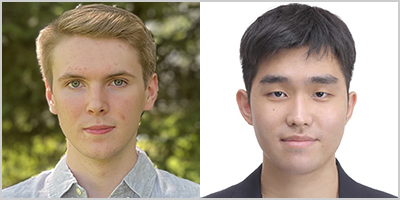 Edward Deleu (ECE ’26) and Wonju Lee (ECE ’26)
Edward Deleu (ECE ’26) and Wonju Lee (ECE ’26)
Advised by Minjie Chen
Automatic Characterization of High-frequency Power Magnetic Materials
Power magnetics are key components in power electronics systems. They determine the volume, size, and efficiency of power electronics and play important roles in renewable energy systems and transportation electrification. This project will develop a systematic approach to rapidly and autonomously characterize power magnetic materials at high frequencies. Operating magnetic components at high frequencies can reduce the size of power electronics systems and benefit a wide range of applications. The students will learn about power electronics characterization, machine learning, and data engineering.
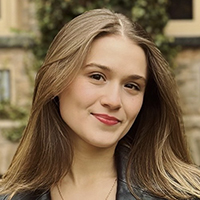 Diana Savchyn (CBE ’25)
Diana Savchyn (CBE ’25)
Advised by Jonathan Conway
Analyzing the Sugar Transport System in the Extremely Thermophilic, Lignocellulose-degrading Bacterium Caldicelulosiruptor bescii
Cellulosic biofuels could play a vital role in addressing the climate and energy crises of the 21st century. However, biofuels face constraints to economic viability due to the difficulty of degrading lignocellulose feedstocks. Caldicellulosiruptor bescii, a non-model, extremely thermophilic bacterium, is an emerging metabolic engineering host organism due to its highly effective lignocellulosic enzyme inventory and rudimentary genetic system. Nevertheless, the potential of C. bescii as a model microbial platform for biofuels production is limited by a relatively poor understanding of its sugar transport systems for moving extracellular oligosaccharides inside the cell for metabolism. We aim to resolve this challenge by characterizing structure-function relationships in C. bescii’s repertoire of ABC sugar transporters to predict transported substrates. Using well-established protein expression and crystallization workflows, we will obtain three-dimensional protein structures of the substrate-binding-domains in each ABC sugar transporter. Altogether, our efforts will accelerate the development of C. bescii as a model metabolic engineering platform for biofuels production.
 Camila Cabrera Martinez (CBE ’24)
Camila Cabrera Martinez (CBE ’24)
Advised by Jonathan Conway
Analyzing and Engineering Cellulase and Hemicellulase Enzymes for Lignocellulosic Biofuels Applications
Cellulosic biofuels could play a vital role in addressing contemporary climate and energy crises, but their economic viability faces constraints due to the difficulty of completely degrading lignocellulosic feedstocks. Enzymes from extremely thermophilic microorganisms are of interest for their ability to be incorporated in biomass processing steps that operate at elevated temperatures prior to sugar fermentation. Through this project we will explore unique hemicellulases and cellulases from extremely thermophilic microbes. We will clone and produce these enzymes for biochemical characterization and assess their ability to be incorporated in biomass treatment processes. These data will help inform engineering of enzyme mixtures to improve plant biomass degradation processes to achieve the goal of producing biofuels and biochemicals from lignocellulosic biomass sources.
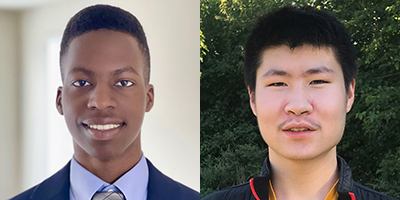 Justin Smallwood (MAE ’26) and Hao Teng (COS ’26)
Justin Smallwood (MAE ’26) and Hao Teng (COS ’26)
Advised by Kelsey Hatzell
X-ray Imaging of Solid-state Batteries
Next generation, energy-dense solid-state batteries could play a critical role in applications related to electric vehicles, portable electronics, and grid energy storage. However, assessing failure onset and growth mechanisms in solid electrolytes is necessary to achieve high-performance solid-state batteries. While a phenomenological understanding of failure mechanisms in solid electrolytes exists, limited experimental validation is available. The students will engineer in situ and operando devices to investigate solid-state batteries during realistic operating conditions, and they will use x-ray imaging tools to visualize material transformation pathways.
 Alex Moosbrugger (CEE ’24)
Alex Moosbrugger (CEE ’24)
Advised by Jesse Jenkins and Fangwei Cheng
Evaluating the Trade-off between Carbon Removal Technology, Fossil Fuels Coupled with Carbon Capture, and Hydrogen on Deep Decarbonization of the Power Sector
A rapid transition to a net-zero carbon emissions power grid is expected to be the linchpin for economy-wide decarbonization. As variable renewable energy penetration increases, firm power generators that provide dispatchable power generation will become critical for preserving a reliable and economical power grid. The student will assist in the techno-economic evaluation of different combinations of firm generators, including (1) natural gas combined cycle with 100% CO2 capture rate, (2), natural gas plants with 90% or 0% CO2 capture rate, with direct air capture to offset fossil emissions, and (3) H2 turbines. The student will learn the role that different combinations of generators will play in the future electricity system and use a capacity expansion model (i.e., GenX) for future power system planning under uncertainty.
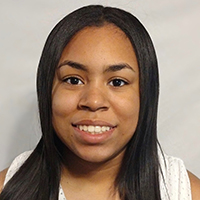 Desiree Rivers (MAE ’26)
Desiree Rivers (MAE ’26)
Advised by Yiguang Ju
Plasma-assisted Ammonia Synthesis
Ammonia is an extremely important chemical for agriculture, plastics, and explosives. Unfortunately, the conventional method for generating ammonia is energy-intensive and requires high pressures. By contrast, using plasma to assist with the synthesis of ammonia could reduce its associated environmental costs, since plasma generation can occur at lower temperatures and pressures. In this internship, the student will work with a graduate student to conduct experimental studies of plasma-assisted ammonia synthesis involving laser diagnostics in a pulse plasma-activated plasma reactor, with the overall goal of synthesizing ammonia more efficiently and with fewer pollutants than the conventional method.
 Tal Shpigel (ECE ‘26)
Tal Shpigel (ECE ‘26)
Advised by Egemen Kolemen
Liquid Metal Technology for Fusion Engineering
Fusion reactions often involve confining high-temperature plasmas for significant periods of time within a reactor. However, solid metals used in the wall of fusion reactors have a difficult time withstanding the extreme heat fluxes that happen during those reactions. In this project, the student will help to develop a liquid metal technology, which could be better able to withstand heat fluxes during fusion reactions. The student will run numerical simulations available in OpenFOAM of the free surface flow of the technology with magnetohydrodynamics, or they will assist with running experiments in the lab.
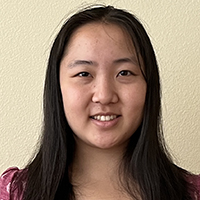 Kayla Xu (COS ’26)
Kayla Xu (COS ’26)
Advised by Egemen Kolemen
Machine Learning for Fusion Data
One of the primary goals in current fusion research is to develop reactors that are able to maintain high-density, high-temperature plasmas for significant periods of time. However, existing models for plasma evolution are typically slow and computationally costly. In this project, the student will use machine learning methods to develop better real-time methods for plasma control in fusion reactors. The student will be asked to help design control policies based on labeled and unlabeled data from previous fusion experiments.
 Lilianna Gittoes (ORF ’24)
Lilianna Gittoes (ORF ’24)
Advised by Eric Larson and Fangwei Cheng
Carbon Balances for Forest-based Bioenergy with CO2 Capture and Storage
Fuels synthesized from sustainably produced biomass coupled with carbon capture and storage could play a critical role in achieving economy-wide net-zero greenhouse gas emissions by 2050. However, quantifying the positive contributions to climate change mitigation from forest-derived biomass remains challenging. On one hand, sustainable forest management practices, utilization of bioenergy to substitute fossil fuels, and carbon capture and storage of biogenic CO2 (generating negative emissions), effectively reduce CO2 emissions. On the other hand, forest bioenergy is not immediately carbon-neutral, as emissions from the supply chain and forest carbon contribute emissions to the atmosphere. This project aims to establish a novel framework for accurately quantifying the value of forest bioenergy in achieving net-zero goals compared to counterfactual scenarios where the energy carriers are provided by other sources. The student will assist with using forest models (e.g., the USDA Forest Vegetation Simulator) to generate growth data of different types of species under various forest management practices.
 Clara Bloom (CEE ’26)
Clara Bloom (CEE ’26)
Advised by Eric Larson and Arya Gunawan
CO2 Capture, Transport, and Storage Hubs for Decarbonizing Industry
The Princeton Net-Zero America (NZA) study highlighted the importance of CO2 capture and storage (CCS) for meeting the U.S. goal of net-zero greenhouse gas emissions by 2050. Building on the NZA study, researchers in the Andlinger Center’s Energy Systems Analysis Group (ESAG) are exploring opportunities for deploying CO2 capture, transport, and storage systems to serve existing “hard-to-decarbonize” industries and power plants and hypothetical future facilities. This project will investigate alternative time-evolution pathways for the development of clusters of capture plants and storage sites connected through shared CO2 pipeline infrastructure. The work will use the Louisiana-Gulf Coast region as a case study, one of the most heavily industrialized regions in the U.S., which also happens to be co-located with some of the country’s best prospective underground CO2 storage resources. The student will assist with modeling, analysis, and post-processing visualization in the project.
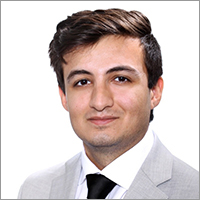 Dawood Virk (CBE ’25)
Dawood Virk (CBE ’25)
Advised by A. James Link
Engineering of PET-degrading Enzymes
Polyethylene terephthalate (PET), commonly referred to as polyester, is one of the most widely manufactured thermoplastics and is frequently used in the textile and packaging industries. However, PET, like other synthetic plastics, can be difficult to break down after use. As a result, PET has contributed to the accumulation of plastic waste, a problem that poses major environmental and economic concerns. In this project, the student will work on the rational engineering of enzymes (known as PETases) that are capable of degrading PET. In particular, the student will focus on engineering PETases that work at elevated temperatures.
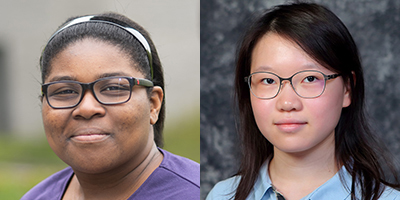 Ayanna Smith (MAE ’25) and Kelsey Wang (CHM ’24)
Ayanna Smith (MAE ’25) and Kelsey Wang (CHM ’24)
Advised by Forrest Meggers
Heat Pumps to Save the World
Heat pumps have garnered attention for their potential to shift our energy system away from natural gas. Shifting to an electrically driven heating supply from a largely gas-based one has many challenges and opportunities. Heat pumps can dramatically reduce energy consumption when combined with geoexchange. They can also enable thermal storage that can, in turn, enable electrical load shifting to facilitate use of variable renewable sources without batteries while being integrated with more effective thermal comfort delivery in buildings. This project will contribute to ongoing work in the CHAOS lab to research the design, control, and smart building integration of heat pumps. The students will work with researchers on prototype heat pump experiments and control systems, and they may contribute to larger analyses that model the impacts of shifting to heat pump systems.
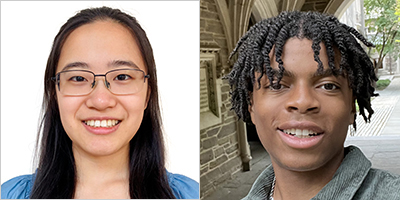 Yiling Li (Undecided ’26) and Tersoo Upaa (ECE ’26)
Yiling Li (Undecided ’26) and Tersoo Upaa (ECE ’26)
Advised by Barry Rand
Plasmon Enhanced Light-mediated Chemical Processes
Chemical manufacturing accounts for nearly 10% of global energy consumption. Recent research has explored light-mediated chemical processes as a means of increasing the efficiency of chemical manufacturing. This summer internship will explore the use of plasmons to enhance upconversion of light, wherein two low-energy photons are incoherently ‘combined’ to form a higher energy photon. The students will fabricate thin films of organic semiconductors, metals, and dielectrics using both spin coating and thermal evaporation, and use various characterization and data analysis techniques to measure optical and electronic properties of samples.
 Sophia Miller (CBE ’26) and Matthew Oh (CBE ’25)
Sophia Miller (CBE ’26) and Matthew Oh (CBE ’25)
Advised by Michele Sarazen
Conversion of Waste Plastics on Tailored Bifunctional Catalysts
Most plastic waste originates from single-use packaging, as current recycling and recovery technologies are often impractical or not economically viable. As such, chemical recycling or conversion methods can serve as potential ways to break down plastics into liquid products that can be used as fuels and chemical intermediates. Here, we utilize tailored bifunctional metal/acid catalysts to convert polyolefins to fuels and chemicals under mild conditions to probe effects on metal accessibility and identity (including bimetallic species) on reaction mechanism and catalyst stability. This project will involve: (1) synthesis and characterization of catalysts, (2) operation of conversion reactions in a Parr reactor, and (3) characterization of solid, liquid, and gaseous products.
 Dominic Riendeau-Krause (ORF ’25)
Dominic Riendeau-Krause (ORF ’25)
Advised by Ronnie Sircar
Quantifying Uncertainty in Electricity Generation
Renewable energy resources can reduce carbon footprints and marginal costs, but they also introduce risk to the grid that is not fully accounted for under current operational paradigms. Modern electricity markets face new sources of risk as the footprint of renewables increases, and price formation in the traditional sense will ultimately be subordinated to reliability quantification. The student will assist with the ORFEUS project, which ascribes risk and costs to each asset’s contribution to system operational cost. The project’s major components include nodal load and generation scenarios, analysis of system operation costs, risk allocation and construction of system risk indices, and securitization and risk transfer.
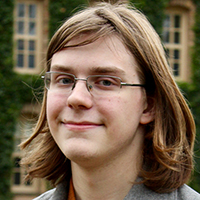 Kelvin Green (CEE ’24)
Kelvin Green (CEE ’24)
Advised by Howard Stone and Fernando Temprano-Coleto
Diffusiophoresis for the Efficient Remediation of Microplastics
The presence of microplastics in natural waters is one of the greatest environmental challenges of our time. Since traditional wastewater treatment typically does not include high-end microfiltration or ultrafiltration steps (due to their high cost), most small microplastics are not successfully captured from used water. Recently, diffusiophoresis (the spontaneous motion of solids in the presence of concentration gradients) has been proposed as an inexpensive alternative to separate microscopic solids from water. In this project, the student will (1) build microfluidic channels to observe and quantify this separation process at small scales, (2) analyze and process experimental results, comparing them to theoretical models, and (3) explore the usage of different chemicals to induce diffusiophoresis, in order to simultaneously achieve filtration and chemical treatment of water.
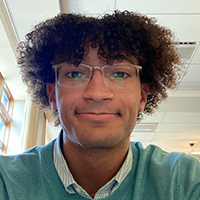 Colin Bausley (CBE ’26)
Colin Bausley (CBE ’26)
Advised by Howard Stone and Fernando Temprano-Coleto
Capturing Microplastics from Water Using Inertial Microfluidics
Microplastic contaminants have gradually emerged as one of the most important environmental challenges of our time. While wastewater treatment facilities effectively remove larger microplastics, smaller particles below 10 mm are often not removed. Membrane filtration is capable of removing such small particles but is often cost-prohibitive for many municipal water and wastewater facilities. Another method that has proven effective at removing microplastics is oil/water-based separations, as microplastics have a strong affinity for oil phases. In this project, the student will help to design spiral microfluidics with oil-filled pores for inertial separations. Particles with a density slightly greater than that of water should partition towards the outside of the curvature and be capture in the oil-pores there, while particles with densities lower than that of water should migrate towards pores located on the interior.
 Aaron Dantzler (ORF ’25) and Bibiane Kan (ECO ’26)
Aaron Dantzler (ORF ’25) and Bibiane Kan (ECO ’26)
Advised by Elke Weber
Social Norm Dynamics and Behavior and Organizational Change Towards Net-zero Carbon Emissions
The students will work on one of several projects focused either on the deep and rapid decarbonization of energy systems or on climate adaptation planning processes of the United States, India, and areas of Europe. The students will assist in comparative research efforts to model perceptions of and responses to energy or disaster management policy and system change and identify behavioral barriers to decarbonization or risk reduction actions. Potential topic areas include willingness to adopt and install energy structures (e.g. smart grids, electricity transmission lines), exploring mechanisms for corporate and urban institutional climate action, and investigating climate adaptation and mitigation behaviors, focusing both on understanding existing social norms and perceptions of these environmental areas and the institutions, agents, and other forces that impact them.
 Sonia Ghoshal (ECE ’26) and Laura Wunderlich (CEE ’24)
Sonia Ghoshal (ECE ’26) and Laura Wunderlich (CEE ’24)
Advised by Claire White
Decarbonizing the Cement Industry
Professor White’s research group is focused on developing new sustainable concrete by understanding and optimizing the sub-micron processes (i.e., reactions) occurring in conventional and alternative cements. This internship will complement ongoing projects being undertaken in the group and will include working in a wet lab with graduate students to synthesize materials and perform materials characterization measurements. The student will use and learn various experimental characterization equipment, such as X-ray diffraction, Fourier-transform infrared spectroscopy, and thermogravimetric analysis.
Internships with Non-profit and Government Organizations
 Kevin Yang (ORF ’26)
Kevin Yang (ORF ’26)
American Council for an Energy-Efficient Economy (ACEEE)
Messaging Comprehensive Retrofits
While individual home energy projects can help reduce energy use, combining home energy retrofits together reduces the total cost of ownership and produces savings that are orders of magnitude greater than one-off projects. But how can homeowners be persuaded to upgrade their whole homes rather than just a few pieces? The ACEEE Behavior and Human Dimensions Program conducts research on energy efficiency from a behavioral perspective and will be examining this question through a combination of research and experimentation. The student will conduct background literature reviews and preliminary studies to inform the design and implementation of a messaging experiment. ACEEE will publish this study in 2023, with the goal of informing the U.S. Department of Energy, contractors, and program implementors how to best encourage comprehensive energy retrofits among homeowners.
 Aditi Desai (SPI ’24)
Aditi Desai (SPI ’24)
Environmental Defense Fund (EDF)
Energy Transition Analytics
The student will play a central role in conducting research and analysis on the oil and gas sector and emerging energy transition topics to inform communications aimed at investors and financial institutions. The student will be a key team player in developing thought leadership for EDF’s new investor insights platform, which intends to equip the financial community with the independent analysis and tools needed to manage climate risk, assess opportunities, and accelerate urgent action in the sectors that matter most.
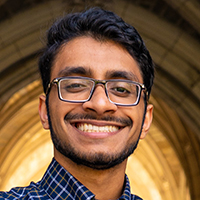 Sameer Riaz (MAE ’24)
Sameer Riaz (MAE ’24)
Federal Energy Regulatory Commission
Energy Markets Regulation
FERC’s Office of Energy Market Regulation, Division of Electric Power Regulation analyzes regulatory filings involving Regional Transmission Organization (RTO)/Independent System Operator (ISO) wholesale electricity markets and other electric rate matters related to wholesale energy sales and transmission of electric energy in interstate commerce. The student will learn about the fundamentals of wholesale electricity markets from FERC experts, participate in interdisciplinary teams analyzing regulatory filings, and work with a mentor to define an independent research project at the intersection of engineering, economics, and policy.
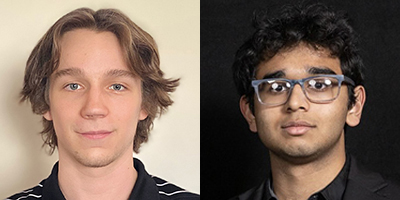 Kyle Gschwend (CEE ’26) and Rutva Shah (CEE ’26)
Kyle Gschwend (CEE ’26) and Rutva Shah (CEE ’26)
Moonshot Missions
Utility Technical Advisor Research
Moonshot Missions is currently working on topics related to environmental equity, such as drinking water and wastewater operational optimization and affordability, providing access to clean water in communities across the U.S. The work aims to level the playing field in the water sector, so every American has access to clean and affordable drinking water and sanitation services. The students will apply research and knowledge to address the challenges facing drinking water and wastewater utilities, particularly in economically distressed communities.
Read about past internship projects and experiences below:
2022, 2021, 2020, 2019, and 2018 recipients
Arielle Rivera: Lighting Puerto Rico’s energy future
From bird watching to code writing, Riti Bhandarkar reflects on her path to energy
Andlinger summer program yields summer exploration and new pathways
People spotlight: Audrey Shih – studying polymer flow for groundwater remediation